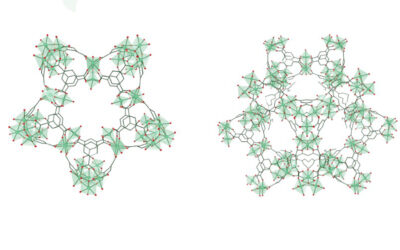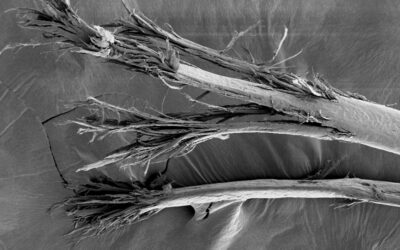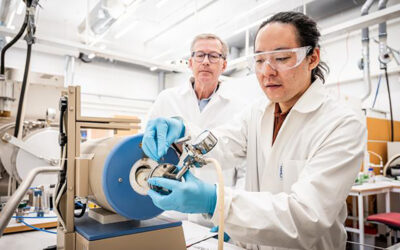Walking down the personal care aisle at the supermarket, one might justifiably conclude that sulfates are an ingredient to avoid in shampoos. More and more brands offer a wide range of sulfate-free options, and some consumers are even turning to alternative choices, such as washing one’s hair with only water or vinegar, giving up shampoo entirely.
The sulfate-free shampoo movement has been gaining popularity for at least two decades, and yet sulfates are key for the shampoo’s cleaning ability. They are a type of surfactant, which is “the chassis” of the shampoo, said Anthony Ryan OBE, professor of physical chemistry at the University of Sheffield and co-author of a recent study exploring the topic.
So, is shampoo a thing of the past? Current scientific consensus says, no. The study published in Macromolecular Chemistry and Physics reviews the components of shampoo with the ultimate goal of making it as kind to the skin and to the environment as possible.
Tadpoles get rid of oils
“A surfactant molecule looks like a tadpole,” Ryan explained, with a head that is soluble in water and a fatty tail which isn’t. The tail is thus capable of removing the oily deposits on the hair, while the head attaches them to the water in order to rinse them away.
Many of these oily deposits are due to sebum, a natural substance produced by a gland at the root of the hair that keeps it lubricated — but also makes hair look greasy as it builds up. Because sebum is oily, neither water nor vinegar can remove it, as oil is not soluble in water.
“Hotter water […] reduces the surface tension between the oils and the water, so more will maybe dissolve a bit if you scrub really hard. It’s a bit like an oily plate,” said science educator and cosmetic chemist Michelle Wong, who was not involved in the paper.
But, much like with oil on a plate, the result of just hot water is never perfect. Vinegar, as an acid, might help remove oily deposits that are alkaline, Wong added, but “most of the components of sebum [are] neutral and not water soluble, so it won’t get rid of that”.
While surfactants are good at removing sebum, they “cannot distinguish sebum from the protective lipids in your hair lengths, [so they can remove them too],” added Heleen Kibbelaar, researcher in complex fluid systems at the University of Amsterdam who was also not involved in the study. “It’s not horrible for your hair, but if I need to give a disadvantage of shampoo, then that’s the disadvantage.” Pre-wash oils mitigate this effect, though.
Pollution also builds up on hair
It’s possible that after several weeks of not using shampoo and putting up with greasy-looking hair, sebum would eventually spread through the hair and find its own balance. However, other deposits from styling products or external pollution (which water or vinegar are no better at removing) would still build up and get trapped in the sebum. This could irritate the scalp and possibly interfere with hair growth.
Still, not all surfactants are sulfate-based, so does it make sense to choose sulfate-free shampoos?
“People have vilified sulfate surfactants […] because sulfates are harsher on the skin than other surfactant choices, but they are the best at cleaning, they are the cheapest, they’re the most readily available, the most easily manufactured,” said the study’s co-author, Courtney Thompson, researcher at the University of Sheffield.
Nowadays, she added, shampoo formulations choose the right combination of sulfates with other surfactants to achieve the desired cleaning effect without damaging the skin.
“You can formulate a sulfate-containing shampoo to actually be gentler than a non-sulfate-containing shampoo,” Wong confirmed. In fact, Wong reckons that a possible factor behind the movement towards avoiding products in general might come from apps which scan lists of ingredients and highlight supposedly harmful ones.
“Those apps are very one-dimensional: if it’s in there, it’s bad; if it’s not in there, it’s good. That’s non-science-based logic, there’s not much nuance” in their reasoning, she argued.
And yet, more and more brands are moving away from sulfates and offering alternative formulations, probably because “they’ve given up on trying to convince consumers,” she said.
Towards eco-friendly shampoos
Next on shampoo makers’ to-do list is to become more environmentally sustainable. There are two targets to minimize: impact of the production and transport processes and damage to the waste water system.
While solid shampoo might help cut the carbon cost of transport, to compare the overall impact one should also bear in mind the water involved in the manufacturing process, in case it is much more for solid than liquid shampoo, Kibbelaar pointed out, and in lathering and rinsing.
Other research by Thompson in collaboration with Unilever showed that a biodegradable ingredient which was previously found not to work well might be effective in a different formulation. Biodegradable ingredients should always be preferred, since non-biodegradable ones end up forming microplastics when they go down the drain.
That is why fine-grained research is needed in order to understand how best to formulate shampoo to achieve the desired effects at the least environmental and economic cost. But surfactants will not leave the mix anytime soon.
Reference: Courtney Thompson et al., Shampoo Science: A Review of the Physiochemical Processes behind the Function of a Shampoo, Macromolecular Chemistry and Physics (2023). DOI: 10.1002/macp.202200420

















